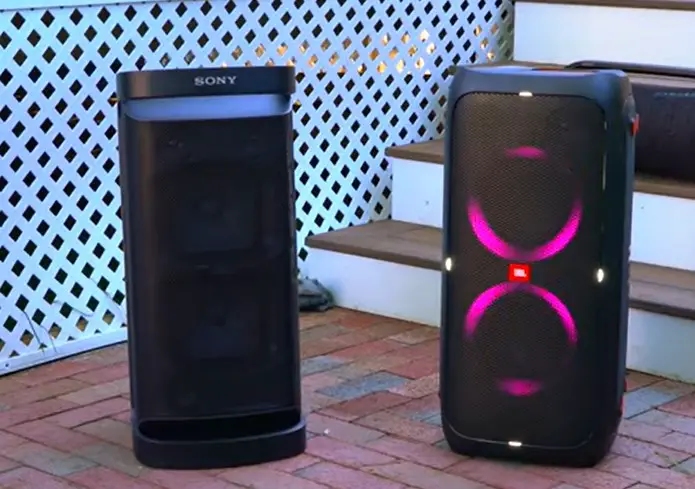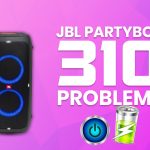You’ve just found out that all your friends are coming over for an outdoor karaoke party, but there’s a catch: you don’t have a suitable outdoor speaker!
The time is short, and you don’t want to get embarrassed in front of your friends by putting the small stereo pair speaker outside. It won’t give a fulfilling sound for your huge yard anyway.
You visit an amazing store filled with various speakers, and two particular models catch your eye. The JBL Partybox 310 and Sony XP700.
But there’s a little problem; you don’t know which one to choose or which would suit the party.
What to do now?
Do nothing; your call for help is heard!
Just read for 10 minutes to choose the best speaker for your party.
Let’s get started!
JBL PartyBox 310 vs Sony XP700 Table for Quick Comparison
| Feature | JBL PartyBox 310 | Sony XP700 |
|---|---|---|
| Design | Vertical placement, rugged, wheels for portability | Can be placed horizontally and vertically |
| Water Resistance | IPX4 | IPX4 |
| Portability | Built-in handle and wheels | Built-in handle, no wheels |
| Battery Life | Up to 18 hours at 50% volume | Up to 25 hours at 25% volume |
| Bluetooth Version | Bluetooth 5.1 | Bluetooth 5.0 |
| Connection Range | 335 feet | 335 feet |
| USB Port | 1x USB-A | 2x USB-A |
| AUX Input | Yes, with controls for mic/guitar input | Yes, without controls for mic/guitar input |
| Additional Ports | 12-volt DC port | None mentioned |
| Sound Quality | More powerful, bass-boost feature, suitable for larger rooms | Good mid-range and high-frequency response, equalizer function in app |
| Control Panel | Lights up, has sound effects and mic controls | Basic buttons, no backlight |
| Check Price | Amazon | Amazon |
This table provides a quick comparison of the key features between the two models. The JBL PartyBox 310 and Sony XP700 both have their own strengths and may be suitable for different user preferences and uses.
Sony SRS-XP700 vs. JBL PartyBox 310: The Ultimate Outdoor Party Speaker Showdown
Design:
Do you believe in love at first sight?

Even if you don’t, you’re most likely to fall for one of the speakers merely for its good looks. In the case of JBL Partybox 310 and Sony XP700, both have almost the same size and design. JBL Partybox 310 is designed for vertical placement, whereas the Sony XP700 can be placed horizontally and vertically.
Both speakers feature a plastic body and a metal grille to protect the sound drivers from damage and accidental drops. JBL speakers are known for their rugged design, which makes them better for outdoor use. They have two rubber feet on the speaker’s right, left, and bottom parts for easy placement and rough handling. In addition, both speakers come with a handle, which helps the user carry the speaker anywhere; however, the JBL Partybox 310 also has wheels making it easier to move this heavy speaker.
Finally, both speakers have RGB lights that synchronize with the music you’re playing, making the party more fun. However, the JBL Partybox 310 has a better RGB light show than the Sony XP700. It has two circular RGB lights in front of the speaker, which can be set to different colors using the JBL Partybox App.
Water Resistance:
Let’s say you’re having a party, and suddenly, it starts to rain; now, you rush back inside the house to save yourself. However, you completely forget about the speaker.
If this happens, you don’t need to worry about speaker damage because both JBL Partybox 310 and Sony XP700 have an IPX4 rating, making them water-resistant. This makes both speakers ideal for outdoor use.
Portability:

No matter how strong you are or how heavy the weights you can lift in the gym, carrying a speaker with you for extended hours can be quite tiresome! You may even think about giving up the speakers or throwing them on the roadside because you’ve been carrying them too long.
So, you’d want to choose a speaker that’ll not only do for the Karaoke party but also be portable enough for other applications.
Both JBL Partybox 310 and Sony XP700 have built-in handles to carry the speaker from place to place. However, JBL takes the lead for a more considerate design option, i.e., the JBL Partybox 310 has built-in wheels. You can easily take this gigantic speaker anywhere by dragging it. However, for the Sony XP700, you’ll have a real test of your strength by carrying it through the handles from one place to another.
Battery Life:
When choosing a speaker for outdoor events or trips, it’s crucial to consider its battery life. You won’t want your speaker to dodge you during a trip, a beach party, or even your hosted Karaoke Party.
So, let’s compare the two speakers’ battery life to know which would be more suitable for a diverse application.
The advertised battery life of the Sony XP700 is 25 hours after a single charge of 2 to 2.3 hours. However, this battery life is achievable when playing the audio at 25% volume, with the lights turned off and the bass feature turned on. However, the battery life may vary depending on the speaker’s volume, the type of audio you’re playing, and the hours of use.
On the other hand, JBL Partybox 310 has an advertised battery life of 18 hours with a single charge of 3 hours. However, this is the ideal battery life for the speaker when playing music at 50% volume and lights and bass are turned off.
However, if you use the speaker for about 30-60% of the volume, with lights and bass turned on, it’ll give you a playback time of about 18 hours for both speakers.
In addition, both speakers have a built-in power bank, allowing users to charge their devices from the speaker. They also have a power-saving feature, which shuts down the speaker after 15-20 minutes of inactivity.
Bluetooth:
Now, let’s discuss the Bluetooth capabilities of both speakers.
Sony XP700 offers Bluetooth 5.0, with a connection range of 335 feet, faster data transmission, and stable connectivity. It can connect to up to two devices, allowing two people to play audio from their smartphones simultaneously.
On the other hand, JBL Partybox 310 takes the extra mile by offering Bluetooth 5.1, which has the same connection range,i.e., 335 feet. This speaker can also be connected to two devices at a time.
Connectivity Options:
Let’s say you want to connect an audio source to your speaker, which doesn’t have a Bluetooth connectivity option. What would you do?
You’ll want a speaker with more connectivity options for such devices, so you need to check the connectivity options offered by JBL Partybox 310 and Sony XP700 to take your pick.
USB Port:
Both speakers have a USB-A port, which allows users to connect devices through USB ports for audio playback and charging. However, the Sony XP700 has two USB-A ports, making it usable for two devices simultaneously, whereas JBL Partybox 310 has just one. It also has a Party Connect feature that allows users to connect a daisy chain of more than one speaker for a more booming effect.
AUX Input:
In addition, both speakers have a 3.5mm audio cable input, allowing them to connect to an audio source through an aux cable. They also have a mic input, where you can plug in a microphone or your guitar for playing or singing, making it ideal for karaoke.
However, JBL Partybox 310 provides controls to adjust the microphone or guitar input’s bass, treble, and echo. It also has some preloaded sound effects to make karaoke more fun. In addition, it also has an audio in and out port, unlike the Sony XP700, which allows the user to daisy chain it with another JBL speaker.
Isn’t it amazing?
Well, wait, there’s more to it.
JBL Partybox 310 also has a 12-volt DC port, so you can connect it to the car during a camping trip and enjoy the music.
Sound Quality:
The JBL Partybox 310 has a pair of subwoofers and a pair of tweeters at the front, whereas the Sony XP700 also has two woofers but four tweeters, where one is at the backside to help bounce off the sound if it’s placed closer to the wall. The rest of the three tweeters are at the front, where two are in the front-top corners and one at the bottom right corner.
Now, you might be wondering why the tweeters are placed this way.
It’s because the Sony XP700 is suitable for both Vertical and horizontal placement. So, the top two tweeters are active when the speaker is placed vertically. When you put the speaker horizontally, the sensor signals the speaker and the top right and bottom right tweeters are active and playing sound. It’s also important to know that all the tweeters are not always active; a built-in speaker activates them according to the speaker’s placement.
JBL Partybox has an excellent frequency response of 35HZ to 20KHZ, with a power output of 140 Watts RMS, whereas the Sony XP700 has a power output of upto 100 Watts RMS and frequency response of 50 Hz to 20 KHz. It means that Partybox 310 provides a more powerful sound and bass performance. This speaker is suitable to fill larger rooms and covers all frequency-range audio.
Furthermore, it can also deliver quite an impressive bass with its Bass-Boost feature, if the speaker is connected to the power outlet, the sound quality gets even better.
On the other hand, Sony XP700 has a decent audio signature but is not as loud as its competitor JBL Partybox 310. It may sometimes struggle to produce clear and punchy bass responses because of the frequency response range. However, it has an amazing mid-range and high-frequency audio response. It also has an equalizer function with the companion app, allowing users to adjust the bass, mids, and trebles as required.
So, overall, JBL Partybox 310 provides a better sound effect.
If you’re interested in how the JBL Partybox 310 compares with other models, you can read more about the comparison with Boombox 2 and the comparison with Partybox 710.
Control panel:
The control panel of JBL Partybox 310 and Sony XP700 is on top of the speaker. The JBL Partybox 310 has the following buttons in the control panel.
- The play and pause, volume up and down, and a Bluetooth button.
- Dedicated Bass boost, Sound Effects, and a mic input audio control with Bass, Treble, and Echo buttons, which allows you to adjust the mic audio.
- A battery level indicator allows you to monitor the battery percentage.
- One amazing feature of JBL Partybox 310’s control panel is that it lights up, whereas Sony XP700 doesn’t.
Like JBL Partybox 310, Sony XP700 has similar basic buttons.
- Volume buttons, Play/Pause, Bluetooth, and a Mega Bass button.
- A Party Connect button, which allows the speaker to connect to different speakers with similar features.
- A battery button, which shows the battery percentage when you press it.
- A light button to turn the RGB lights off and on.
Price:
Now comes the budget!
You may not want to go far beyond your budget to get a speaker for the party. However, with a close margin, if you’re getting something better, I suggest adding the extra money for the real deal.
The Sony XP700 price ranges from 400$-450$, whereas the JBL Partybox 310 is slightly more expensive with a price range of 500$-600$.
Ready to Rock Your Party?
The choice is yours, and both speakers promise to deliver an unforgettable experience. Whether you want the robust and powerful JBL PartyBox 310 or the versatile and budget-friendly Sony XP700, you’re just one click away from transforming your next gathering into a musical extravaganza.
- JBL PartyBox 310: Unleash the thunderous bass and crystal-clear sound that only JBL can offer. With its rugged design and impressive features, it’s the ultimate party companion. Don’t miss out; grab yours now and let the party begin!
- Sony XP700: Looking for something sleek and sophisticated without breaking the bank? The Sony XP700 offers quality sound and elegant design at an unbeatable price. Get yours today and elevate your audio experience!
Don’t wait; these speakers are flying off the shelves. Click the links above and bring home the sound that will make your next party unforgettable!
What Users Say: JBL PartyBox vs. Sony XP Series
Detailed Metrics and Testing Result:
- Sound Quality: Users have mentioned that the JBL PartyBox 310 has a deeper bass compared to the 110. The Sony XP series, especially the XP700, is often compared to the JBL PartyBox 310 in terms of loudness, but some users feel that the Sony doesn’t match up in terms of bass depth or overall sound quality.
- Volume: The Sony XP series can get loud, especially when plugged in. However, some users believe that the JBL PartyBox 310 can produce louder sound without compromising on quality.
- Portability: The JBL PartyBox 310, despite its size, is praised for its built-in wheels, making it relatively portable. The PartyBox 110, on the other hand, is considered less portable due to its size but still delivers a powerful sound.
Pros and Cons:
Pros:
- JBL PartyBox 310: Deep bass, loud volume, portability with built-in wheels, and clear mids and highs.
- Sony XP700: Loud volume when plugged in, competitive pricing in some regions.
- JBL PartyBox 110: Good balance between size and power, delivers a club-like feel, and is versatile for both indoor and outdoor use.
Cons:
- Sony XP series: Some users feel it lacks deep bass and overall sound quality compared to the JBL PartyBox series.
- JBL PartyBox 110: Some users believe it doesn’t deliver as deep a bass as the PartyBox 310.
User Reviews:
- A user named epicsuckz recommended the JBL PartyBox 310, praising its sound quality, especially the heavy bass. They also highlighted the speaker’s portability due to its built-in wheels.
- Every_Personality_87 advised against the Sony XP series, stating that even Sony’s most expensive model, the XV900, couldn’t match the bass of the JBL PartyBox 310. They also mentioned owning the PartyBox 110 and praised its club-like feel.
- Sad-Sample-6095 expressed a preference for more compact speakers, suggesting that the larger “disco machines” might not focus as much on sound quality.
- Baby_Oil emphasized that the JBL speakers, especially the PartyBox series, offer better bass and clarity than the Sony XP series. They also mentioned that the Sony speakers only match the JBLs in loudness when plugged in.
Which one’s better?
Now is the time to announce the winner!
So, in a huge round of applause, JBL Partybox 310 stands tall as a winner. With its great power output, deep and punchy bass, amazing frequency response, portability, diverse connectivity options, better RGB light show, and glowing control panel, it stands out as a winner and is the best option. If you’re still unsure, you can read a detailed review of the JBL Partybox 310 or see how it compares with Partybox 300. Although it’s a bit costly, with all the features this speaker offers, it’s worth the price.
On the other hand, if you’re a bit low on budget, the Sony XP700 is also a decent option for its decent audio response, easy-to-use control panel, water resistance, and Bluetooth, USB, and Aux input options.
Ultimately, it all comes down to personal audio preferences and your budget. Although JBL Partybox 310 is a winner, you may have to choose the other one because of the sound signature and the budget.
Ready to Make a Decision?
Now that you have reached this far, you must have known both speakers’ key points and would already have decided which speaker to purchase. However, if you’re still lost, you must have skipped a part or two of the text. So, I’d suggest you go back and give it a thorough read, as you won’t want to embarrass yourself in front of your friends for throwing a party without immersive music.
Finally, choosing between JBL Partybox 310 and Sony XP700 depends on personal preferences such as audio priorities, room size, usability, and, in the long run, your budget. So, choose according to your requirements.

I’m Shaun Conroy, an audiophile & founder of HiFi Audios. Holding a Bachelor’s in Sound Engineering, I bring deep expertise in audio devices and offer insights & recommendations to fellow enthusiasts.






Thank you, this was very helpful. I am going with the JBL310.